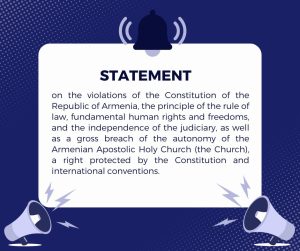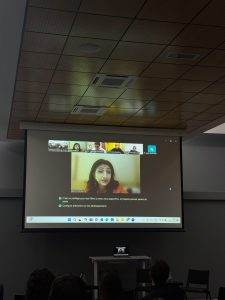
Statement
We, the undersigned civil society organisations and individuals, express our
“Protection of Rights without Borders” NGO, with the support from “Counterpart International” non-profit organization, carried out “The Implementation of the Case Laws in the RA Courts” project for the period from June until September 2012.
People are generally unaware of the way ECHR case-laws are interpreted and applied by the RA courts. Furthermore, court judgments are inaccessible to the general public and cannot be easily understood.
Thus, the fundamental decisions issued by the court, which are supposed to play a decisive role in safeguarding the enjoyment of rights of the RA citizens in line with international standards, do not always serve their purpose.
The short-term goal of the Project was to classify those decisions of the RA Court of Cassation, which are based on the case-laws of European Court, according to a number of standards (e.g. articles of the RA Criminal Code) and target laws, explore the regularities of their application and reveal existing gaps and collisions. Based on the results of the study, PRWB intended to draw conclusions and develop recommendations for improving the current policy, which could be afterwards submitted to the concerned parties.
The project also intended to publish a report summarizing the above-stated project outcomes. The long-term goal of the project was to ensure public access to the decisions of the RA Court of Cassation, which are based on the case-laws of the European Court, enhance professional skills of lawyers and other individuals and specialist groups working in the RA judiciary in applying EC case-laws, improve the quality of judicial acts and increase the responsibility of judicial authorities. It also aimed at securing a higher level of rights protection of the RA citizens through ensuring wider application of decisions of the RA Court of Cassation. The project particularly emphasized the need for corresponding measures to secure a uniform approach toward sentence imposition, as well as enhancing the predictability of justice. Another priority objective targeted to ensure the execution of human rights in Armenia in line with European standards.
The project set the following objectives to achieve its goals:
1. Ensure the publicity and accessibility of judgments based on the case-laws of the European Court.
2. Support lawyers and other individuals and specialist groups engaged in the system of justice in developing skills in the application of ECHR case-laws.
3. Safeguard the execution of human rights in line with European standards and promote ECHR case-law values in Armenia.
4. Contribute to a more predictable dispute resolution and extend legal protection of a person.
The above-stated objectives were to be achieved by two main methods; first, through studying relevant court decisions and second, developing practicable recommendations for the court.
The following steps have been taken to achieve the above-stated objectives:
1. Examine the RA court decisions.
The following sources of information had been used during the study:
Attorneys and other experts
Datalex system
Scientific publications, analyses and commentaries on case-laws
Judgments of European Court of Human Rights in which the RA judicial acts were grounded
2. Presentation of initial report and public discussion.
The initial report focused on the following issues:
Inform the concerned parties (attorneys, judges, human rights workers) of the study findings.
Consider alternative viewpoints regarding the inclusion of certain conclusions in the report through discussions and debates
Team-building and training of the participants.
3. Organize trainings to develop skills in carrying out an in-depth presentation of the recommendations summarized in the report, as well as promoting their use.
The goal of the training was to help the participants develop effective skills in carrying out an in-depth report presentation, as well as in solving certain practical problems.
4. Publish a booklet summarizing the findings of the study.
The final handbook Implementation of the Case-Laws of European Court of Human Rights in the courts of the RA included not only the results of the presentation and public discussion, but also alternative suggestions made during the training. It dwelt on the regularities of applying EU convention on the protection of human rights and fundamental freedoms in different RA courts, as well as legal inconsistencies in the application of case-laws. The legal acts reflecting the above-stated regularities, as well as decisions, judgements and verdicts of the courts, which serve as an example for this or that aspect of law are presented in the appendix of the book.
post
Implementation of the case laws of European court of human rights by the RA courts

We, the undersigned civil society organisations and individuals, express our

The Protection of Rights Without Borders team participated in the

On December 4, Hasmik Harutyunyan, Legal Expert at the Protection

On November 25, IPAS legal expert Anna Melikyan participated in